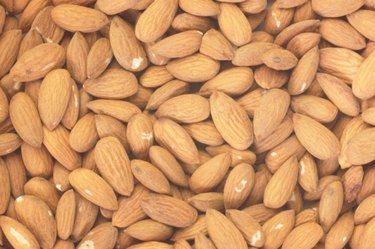
Natural almond flavoring covers a variety of different ingredients. They can be essential oils, powders or essences. Almond extracts are made by combining almond oil from the non-edible bitter almond with alcohol to create a more stable, longer-lasting almond flavoring agent. Almond flavor and extract are most commonly used in cookies and baked goods and pair well with fruits.
Manufacture
Video of the Day
Extracts are made by infusing a liquid (usually alcohol) with a flavor, usually by soaking the flavoring ingredient in the alcohol for an extended period of time. Essential oils are made by extracting the pure oil from an ingredient such as a spice or fruit by pressing or juicing it. Flavored powders are made by grinding up the ingredient to create a dry solid.
Video of the Day
Uses
Extracts and flavorings are often used interchangeably in recipes, but there are some instances where one is preferable. In dry mixes, flavored powders are better. In instances where alcohol can interfere with the way the recipe works, like in some chocolate candies where hardening is affected by alcohol, flavorings or other non-alcoholic choices are best. In baked goods, they can often be used interchangeably.
Intensity
Extracts are more potent than flavored powders and should be used in small amounts (usually one teaspoon). Essential oils are more potent than extracts and should be measured in drops. Liquid flavorings are often similar to extracts in potency and are used in the same amounts.
Allergies
Natural almond flavoring and extract can both be made from real almonds and anyone with a tree-nut allergy should avoid them. Artificial almond flavorings may not contain any actual almonds. Some natural almond flavorings are natural in that the flavor comes from non-synthetic sources, such as bananas or apricot pits, but they may not include natural almond flavors. Always check the label before using any almond-flavored additive if you have a tree-nut allergy.